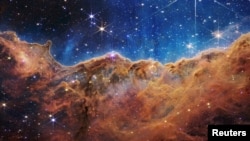Two days after Tuesday’s historic release of the first images from the Webb Space Telescope, data from the telescope’s commissioning period was released on the Space Telescope Science Institute's Mikulski Archive for Space Telescopes.
The data includes images of Jupiter and spectra for several asteroids which was captured to test the telescope’s instruments.
“We are slowly rolling out the data that scientists will use to make their scientific discoveries,” said Susan Mullally, deputy project scientist for James Webb Space Telescope in an exclusive interview with VOA.
The rest of the commissioning data was used to calibrate Webb and measure its performance, added Mullaly.
Asked which of the five new images released on Tuesday she liked the best, Mullaly said it was the Southern Ring Nebula.
“It struck me as such a deep image with so much resolution that I could just see how we could learn about the depth of information about the materials in a star at the end of its life. By studying the winds that are around the Planetary Nebula - the part that’s glowing - you can learn what elements are created, what dust is there. It is actually one of the few ways we get to see inside of a star because the star has sent off all of its material into space for us to look at,” said Mullally.
What Webb Means to the World
“This is information the universe has been sending us, it was on us to collect it. Webb is giving us that opportunity. It means we’ll find out what were the very first stars and galaxies actually like right after the Big Bang. We’ll find what is it like on other exoplanets,” Mullally told VOA.
Although scientists have found over 5,000 exoplanets — planets that orbit a star outside the solar system — “we know very little about their atmospheres and an atmosphere is pretty key to understanding its characteristics,” said Mullally.
Bob Dempsey, an astrophysicist and the former NASA flight director for the International Space Station, was equally excited about the newly released images and Webb’s mission.
“We’re going to learn about how our universe was born, and how planets like our own form and quite possibly how life like ours forms. That will help us in the big picture of knowing where we fit in the universe and how it all came about,” Dempsey told VOA.
Scientists will also learn about practical applications for their discoveries. “For example,” said Dempsey, “we’re experiencing climate change here on Earth; we may be able to get lessons learned from these other planets.”
For Dempsey, the most stunning of Webb image is Stephan’s Quintet.
“It’s an amazing picture of galaxies as they’re interacting. Space is big, galaxies are big. They tend to be hundreds of light years in size, but they’re close enough on a space scale that they’re gravitational pulls are pulling them together and stripping stars from one galaxy to another in kind of a cosmic theft game,” said Dempsey.
Webb could also shed light on the elusive question of whether there is life on other planets.
“A lot of scientists believe that water is fundamental to the formation of life. The fact that there’s billions of stars with millions of planets around them and if a lot of them have water, then the chances of life out there that we’re familiar with seems to me relatively high,” Dempsey told VOA.






